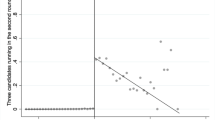Abstract
Over-time and multivariate cross-sectional analyses of large survey samples are used to estimate the likely effects of the National Voter Registration Act (NVRA) by examining turnout in those states where procedures comparable to any of the act's provisions were in force in 1992. In contrast to previous studies, we find that most state motor voter programs did not resemble the NVRA provision. We analyze one state program that did, and in addition use election-day registration as a surrogate, because it also provides one-trip voting. Our two approaches lead to estimates of turnout increases due to the motor voter provision of 4.7 and 8.7 percentage points, respectively. The lack of state counterparts to public agency registration prevents estimates of this provision's consequences. Eliminating purging for not voting will increase turnout by as much as 2 percentage points. Universal mail registration will have no effect. The turnout effects will be greatest among the two largest groups of current nonvoters: people under the age of 30 and those who moved within two years of election day. Neither group is politically distinctive, except for young people's weaker identification with the major parties and greater affinity for third-party candidates.
Similar content being viewed by others
REFERENCES
Avey, Michael (1989). The Demobilization of American Voters. New York: Greenwood Press.
Brians, Craig Leonard (1997). Voter turnout and election day registration. Paper presented at the Annual Meeting of the American Political Science Association. Washington, DC.
Brians, Craig Leonard, and Bernard Grofman (1994). Voter registration laws and turnout in the U.S.: A longitudinal analysis. Paper presented at the Annual Meeting of the American Political Science Association. New York.
Burnham, Walter Dean (1982). The Current Crisis in American Politics. New York: Oxford University Press.
Cloward, Richard A., and Francis Fox Piven (1992). Democracy on wheels. New York Times, June 17: A25.
Crocker, Royce (1990). Voter registration and turnout in states with mail and motor-voter registration systems. Washington, DC: Congressional Research Service.
Earle, Geoff (1995). Motor trouble for Democrats. Governing, August: 25–26.
Fenster, Mark J. (1994). The impact of allowing day of registration voting on turnout in U.S. elections from 1960 to 1992. American Politics Quarterly 22: 74–87.
Gans, Curtis (1990). A rejoinder to Piven and Cloward. PS: Political Science and Politics 23: 175–178.
Heiden, Robert C. (1981). Household goods carriers show some new moves. Handling and Shipping Management 22: 48–51.
Keith, Bruce E., David B. Magleby, Candice J. Nelson, Elizabeth Orr, Mark C. Westlye, and Raymond E. Wolfinger (1992). The Myth of the Independent Voter. Berkeley: University of California Press.
Knack, Stephen (1995). Does “motor voter” work? Evidence from state-level data. Journal of Politics 57: 796–811.
Long, Larry (1991). Residential mobility differences among developed countries. International Regional Science Review 14: 133–147.
Mitchell, Glenn E., and Christopher Wlezien (1995). The impact of legal constraints on voter registration, turnout, and the composition of the American electorate. Political Behavior 17: 179–202.
Montjoy, Robert S. (1992). Motor Voter Registration Programs. Innovations in Election Administration: 6. Washington, DC: National Clearinghouse on Election Administration, Federal Election Commission.
Mullins, Charlotte G. (1992). Using NCOA Files for Verifying Voter Registration Lists. Innovations in Election Administration: 4. Washington, DC: National Clearinghouse on Election Administration, Federal Election Commission.
National Clearinghouse on Election Administration (1992). Fact facts on state registration and election procedures. Technical Report 2. Washington, DC: Federal Election Commission.
National Clearinghouse on Election Administration (1994). Implementing the National Voter Registration Act of 1993: Requirements, Issues, Approaches, and Examples. Washington, DC: Federal Election Commission.
Oliver, J. Eric. (1996). The effects of eligibility restrictions and party activity on absentee voting and overall turnout. American Journal of Political Science 40: 498–513.
Public Law 103–31 (1993). 107 Stat. 77–89.
Rhine, Staci L. (1995). Registration reform and turnout change in the American states. American Politics Quarterly 23: 409–426.
Rhine, Staci L. (1996) An analysis of the impact of registration factors on turnout in 1992. Political Behavior 18: 171–185.
Rosenfield, Margaret. (1992). Agency Voter Registration Programs. Innovations in Election Administration: 5. Washington, DC: National Clearinghouse on Election Administration, Federal Election Commission.
Rosenstone, Steven J., and John Mark Hansen (1993). Mobilization, Participation, and Democracy in America. New York: Macmillan Publishing Company.
Squire, Peverill, Raymond E. Wolfinger, and David P. Glass. (1987). Residential mobility and voter turnout. American Political Science Review 81: 45–65.
Teixeira, Ruy A. (1992). The Disappearing American Voter. Washington, DC: The Brookings Institution.
U.S. Bureau of the Census (1992). Statistical Abstract of the United States: 1992. Washington, DC.
U.S. Congress. House of Representatives. Committee on House Administration (1993). National Voter Registration Act of 1993. 103d Cong., 1st sess., H. Rept. 103–9.
U.S. Department of Transportation (1994a). Driver Licenses—1993. Federal Highway Administration. HPM-40. Washington, DC.
U.S. Department of Transporation (1994b). 1994 Driver License: Administration Requirements and Fees. Federal Highway Administration. HPM-40. Washington, DC.
Wielhouwer, Peter W., and Brad Lockerbie (1994). Party contacting and political participation, 1952–90. American Journal of Political Science 38: 211–229.
Wines, Michael (1993). Senators approve a bill that eases voter registration. New York Times, March 18: A1.
Wolfinger, Raymond E., and Benjamin Highton (1995). Can more efficient purging boost turnout? Berkeley: University of California. IGS Working Paper 95–6.
Wolfinger, Raymond E., and Steven J. Rosenstone (1980). Who Votes? New Haven, CT: Yale University Press.
Author information
Authors and Affiliations
Corresponding author
Rights and permissions
About this article
Cite this article
Highton, B., Wolfinger, R.E. Estimating the Effects of the National Voter Registration Act of 1993. Political Behavior 20, 79–104 (1998). https://doi.org/10.1023/A:1024851912336
Issue Date:
DOI: https://doi.org/10.1023/A:1024851912336




